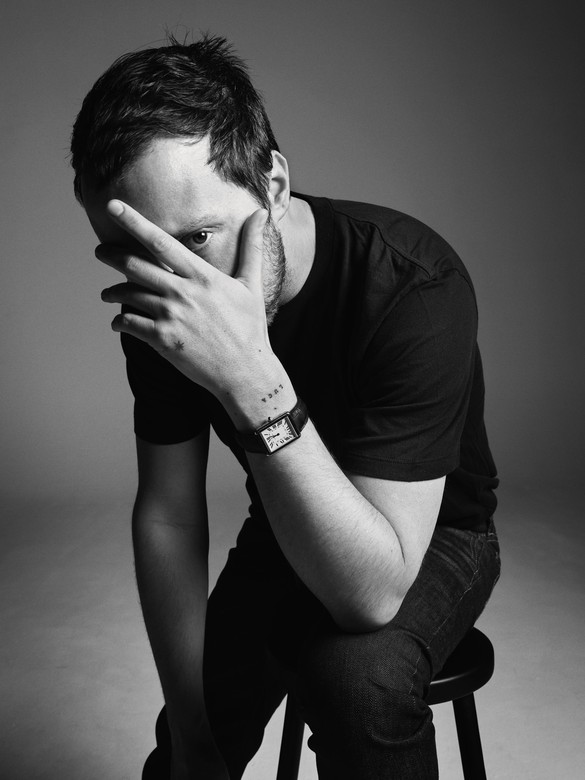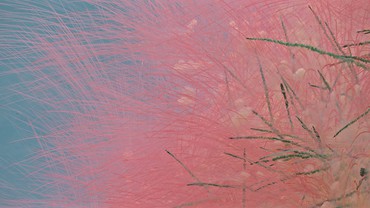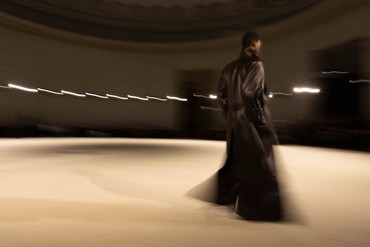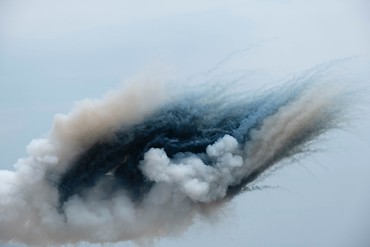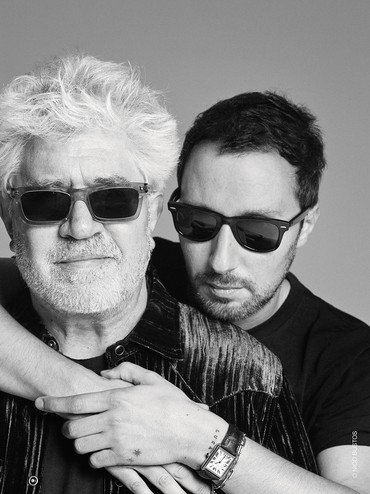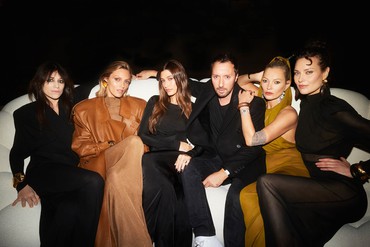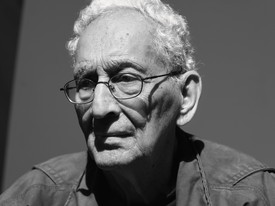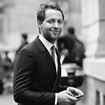
Derek Blasberg is a writer, fashion editor, and New York Times best-selling author. He has been with Gagosian since 2014, and is currently the executive editor of Gagosian Quarterly.
Derek BlasbergBonjour, Anthony! Where am I finding you today?
Anthony VaccarelloI’m in LA, enjoying my last few days here. The weather is beautiful.
DBIt seems like you’ve been spending more time in LA.
AVMy husband and I had an amazing time here when my son was born, and we try to repeat it once a year. When we’re here, it’s only the three of us. No connection to friends, limited work, because we really want to concentrate on [our son] Luca. Luckily, that timing often coincides with when it’s cold in Paris [laughter].
DBAs you know, I want to talk to you about the connection between contemporary art and what you do at Saint Laurent. So let’s start at the beginning. Do you remember the first time you went to an art museum or had an art experience?
AVI was born and raised in Brussels, and as a child I remember being with my parents at the Musée d’Art Moderne. It’s incredibly beautiful because it’s full of these Belgian artists, like Paul Delvaux and René Magritte. But my strongest early art memory was seeing a painting by Francis Bacon. It was one of his popes, and it was like I’d never seen the pope painted before. It was shocking. Let’s say I knew my parents were trying to open my mind and we’d go once a week, or maybe once a month, to a museum, and I liked it when we went there.
DBIn one of the first interviews we ever did together, which was probably fifteen years ago, we talked about our childhood obsession with Gianni Versace.
AVI was drawn to all those designers who loved designing for a woman’s body, like Versace, and Azzedine Alaïa too, but yes, especially Versace. Maybe because of the glamorous things he was surrounded by, including those Pop artists I was so attracted to as a kid. I felt he brought everything into the same universe: fashion, music, cinema. And he was the only one back then mixing all that.
DBVersace didn’t hide his art references. Remember when he used Andy Warhol’s silk screens of Marilyn Monroe on dresses and blouses?
AVYes, he did those Marilyn catsuits, but that was just one thing. I don’t like the idea of using art as a first degree, like taking a piece and doing a dress with that. What I liked with Versace was that it was more a relationship with that world, and the party he created with those people. I think art and fashion are good together, but I don’t like it when it’s too commercial. I think it’s killing the artists and the art, in a way, when you try to incorporate art in design.
DBIn every one of these interviews, we ask the subject: do you think fashion can be art? Can a designer be an artist?
AVI love fashion, but I think perhaps we’re too productive for it to be considered an art. I think we can be artists, or some can be artists, but I don’t know if a piece of art has the same value when it’s unique, and when you don’t have a lot of reproduction. Fashion is maybe too real to be considered an art form. For me, it’s like fashion is part of the art zone, but it’s not art with a capital A.
DBYou’re saying that a designer is more focused on productivity than an artist. So maybe the process is similar—you both mine your memories and inspirations—but your productivity is different?
AVThe value is different. We have maybe the same way of thinking about a story, a woman, or an attitude, but in the end we make something too real to be considered art.
DBWhat’s your design process?
AVIt depends. Usually I need to have a story in my head, like a fantasy about a woman or a boy. I need to think about what they’ll do, where they’ll go. It’s often inspired by film more than music or art, I have to say. I have a problem when someone says that fashion is inspired by . . . a print? A textile? Because when you’re inspired by a print, it’s always something less good, you know? With a painting, it’s so unique and beautiful when you get inspired by something like that.
DBHas your design process changed since our first interview fifteen years ago?
AVNo, it’s pretty much the same. It’s pretty much as painful and complicated as always, ha! To be honest, it can be difficult to do something new and surprising every six months. But for me, the trick is to always have the same DNA in every story but not make people feel bored with what you do.
DBAre you really ever worried that you’re boring?
AVIn fashion, I sometimes have this feeling that we’re here to entertain only a few stupid people. But I guess that’s part of the game.
DBAre there any artists you’re currently inspired by? Who are you looking at in the contemporary art world?
AVThe first person who comes to mind is the artist I saw at the Pinault Collection when it opened in Paris. I can’t remember his name but he had a whole gallery and there was a basketball net with a chandelier—
DBDavid Hammons?
AVYes, that was my favorite thing in the whole museum. Monsieur [François] Pinault told me that it was the first time he’d done a show like that in Paris. It was interesting to see something like that.
DBThere’s a history at the House of Saint Laurent of the designer being inspired by artists. The biggest example that comes to mind is when he made that [Piet] Mondrian dress. What’s it like to work within a legacy like Yves Saint Laurent’s? Do you go and look at those dresses?
AVThose are not my favorite things that Saint Laurent did, the Mondrian, the [Pablo] Picasso. For me, Saint Laurent is more about the style, about the feeling. He was a revolution in fashion! When he took those paintings and made them into dresses, for me it was not the best thing.
DBSo what’s your favorite Saint Laurent era?
AVHis beginning in the 1960s was pretty amazing.
DBThat era is still sexy, too.
AVAnd it’s super modern. But I have to say I’m really touched by his 1990s work too, when fashion started to change with Helmut Lang, all those designers, and he was still focused on the familiar silhouette of the woman he designed back in the day. I’m very touched and emotional when I see that era. It was very different and contradictory of what was happening in the fashion scene. I like thinking I’m starting a collection from that point of view. Like when he left Saint Laurent—I’d like to continue his work since then.
DBYou think you’re picking up where he left off ?
AVWell, yes. Saint Laurent was very inspired in the 1960s and 1970s
—I mean, he invented everything! Now everyone is copying that. So I really want to continue the legacy of the brand, starting where he stopped.
DBLet’s switch gears and talk about Cai Guo-Qiang, an artist who works with fireworks and gunpowder and is collaborating with Saint Laurent. When did you become familiar with his work?
AWI saw an installation called Sky Ladder [2015], which was not supposed to be public but I saw some video on Instagram. I loved the fact that the fireworks were set off during the day and it didn’t feel cheesy. It wasn’t like a Fourth of July party. It was so poetic and so beautiful that it reminded me of that film Zabriskie Point [1970], by Michelangelo Antonioni. At the end there’s an explosion of clothes—you see all these clothes in the sky, falling in slow motion. It’s one of my favorite films. I started to see the world like that.
DBIn 2013 I saw a piece by Cai Guo-Qiang called One Night Stand, where he invited real couples to have sex on a boat in the middle of the Seine, and every time they climaxed he would press a button and a firework would go off.
AVI never saw that. I would have loved to see that!
DBIt was quite erotic because you couldn’t see the couples clearly. They were opaque and only seen in silhouette.
AVI want to see a video!
DBWill any of the work, or any of the collaboration from that piece, result in products for sale?
AVNo. I hate that.
DBHa!
AVI do, I hate it when a brand uses the name of an artist to sell bags or wallets or things like that. It’s the worst thing you can do for artists. The purpose of our collaboration is putting our names together and making something happen, just for the artist to express themselves and to be able to have a platform. There is no commercial purpose behind that.
DBThat sounds so exotic. I thought everything has a commercial purpose now.
AVOf course, I’m lucky to have the support and the resources to do something like that. I know that in other situations, to work with an artist like this I’d have to put his face on a bag or something.
DBThe finances at Saint Laurent look great. You have a fantastic CEO, Francesca Bellettini. Are you aware of the business side of your work?
AVIt’s a good thing that it’s growing, because I don’t have to think about it. I do what I feel moves me. And I think it’s growing naturally because I’m doing things without thinking too much about the commercial side. But I should also say that I’m not crazy. I may do this with an artist, but then I’m also meeting with the design and merchandising teams to focus on creating real clothes. I think that’s what people like. What you see on the runway in images is what you get in the store.
DBYou don’t always see the clothes from the runway in a store. Often, there’s a runway collection and then a commercial collection.
AVIt’s not so different at Saint Laurent. On purpose.
DBThe Saint Laurent universe is growing, including with films. How did the idea of Saint Laurent Productions come to pass, and what are some of its goals?
AVIt happened naturally. A few years ago I started doing these things with a réalisateur. We did something with Bret Easton Ellis and then Gaspar Noé. It was always small projects and I loved it. But I’d get a bit frustrated when they were over because I’d want to do bigger and bigger things.
DBNo more commercials, you wanted to do movies?
AVGoing to the Cannes Film Festival’s midnight screening of a Gaspar Noé film starring Charlotte Gainsbourg and Béatrice Dalle was one of my all-time favorite moments at Saint Laurent. It was three years ago. Being on the steps with Gaspar, Charlotte, and Béatrice, I felt that I wanted to explore that world and do more things with those geniuses. Now I’m working with those réalisateurs who make me who I am today—Pedro Almodóvar, we did some things with Jean-Luc Godard that we’re going to present soon also, and we’re producing the next David Cronenberg. So for me it’s more like, a selfish child is now able to meet and work with people I admired in the 1990s.
DBWhy was that such a big moment for you? Because you felt like it was something beyond a show or a collection?
AVTo be honest, I don’t know. When I was a kid, I always had the fantasy about that midnight presentation because it reminded me of Abel Ferrara’s Blackout [1997], or Gaspar Noé’s Irréversible [2002], those kind of sexy, dangerous films. Being on those steps with those very dark persons, very—yeah, very dangerous people, I feel very . . .
DBSubversive? Sexy? Glamorous?
AVAll of it. I mean, I’m such a fan of Pedro’s, and he was linked to Gianni Versace. It’s part of that hysterical family of the 1990s, you know? I think everything I do has a resonance or link to my youth.
DBWhat’s your favorite part about these kinds of collaborations?
AVIt’s not even about making a costume, because in the end, I don’t care about doing the costumes. It’s a joy to create something for these characters to express their intention. Yes, it’s intention more than clothes.
DBThe logical next question is, Do you want to be a director one day? Maybe you want to be an actor one day?
AVAn actor? No way. That’s for sure. But a director? I don’t know. I’d like to but I need to have a good idea. I don’t want to do something just to do something random. I want to be good. I want to take time to really think about it.
DBIn many ways, what you do is already being a director. It’s a different type of performance, but it’s definitely a creative expression.
AVTrue.
DBAnd I love going to your mini-movies, these incredible fashion shows every six months.
AVThank you for saying that. That’s how I conceive those collections. For me, it’s like showing emotion, not clothes, to people who come to see the collection. Also, I know that people like you see so many shows and you want to feel like you’ve seen something more than just clothes at the end. When I do that, for me, music, scenography, casting the models—I think you have to do all of that so that when you leave one of my shows you feel like you saw a full story.
DBLast question, Anthony. Many people have told me that they’re inspired by your gang, this group that you’ve put together for Saint Laurent. Kate Moss, Charlotte Gainsbourg, Anja Rubik—there’s a Vaccarello posse.
AVI’m happy to hear this question!
DBI haven’t even asked it yet!
AVI know! But, at the beginning, I’d always refuse to invite the types of celebrities or influencers who people would tell me would get a lot of traction but who didn’t have a real understanding of what I was doing.
DBYou mean creators? TikTokers?
AVFor years, I remember people—and I mean people I work with too!—would be surprised that I invited people to my shows who had no Instagram account. But I don’t care! I think of it like building a family, with people that I’m friends with and that I really know. It’s not a fake relationship, it’s people I’m always happy to have around and thrilled to see at my show. It’s almost like a family moment, like Christmas or Thanksgiving, when you’re happy to see like your old auntie or your uncle or a cousin. For me, it’s important because it’s part of the brand and building the brand.
DBEntourages are not new to the house of Saint Laurent!
AVExactly! It’s like what Yves Saint Laurent did in the past; he was really associated with Paloma Picasso, Inès de la Fressange, Betty Catroux, all of the amazing artists in his era. That’s what I tried to build and I’m happy that now people see that and recognize that it was part of the plan.
DBSo this brings me to the question I wanted to ask: how do you get to be part of the Vaccarello family? Like is there an application process, or—
AVNo! It’s actually very simple. You just have to be cool and talented.
DBSo I’m out?
AVHa! Not yet. Maybe.
Photos: courtesy Saint Laurent
